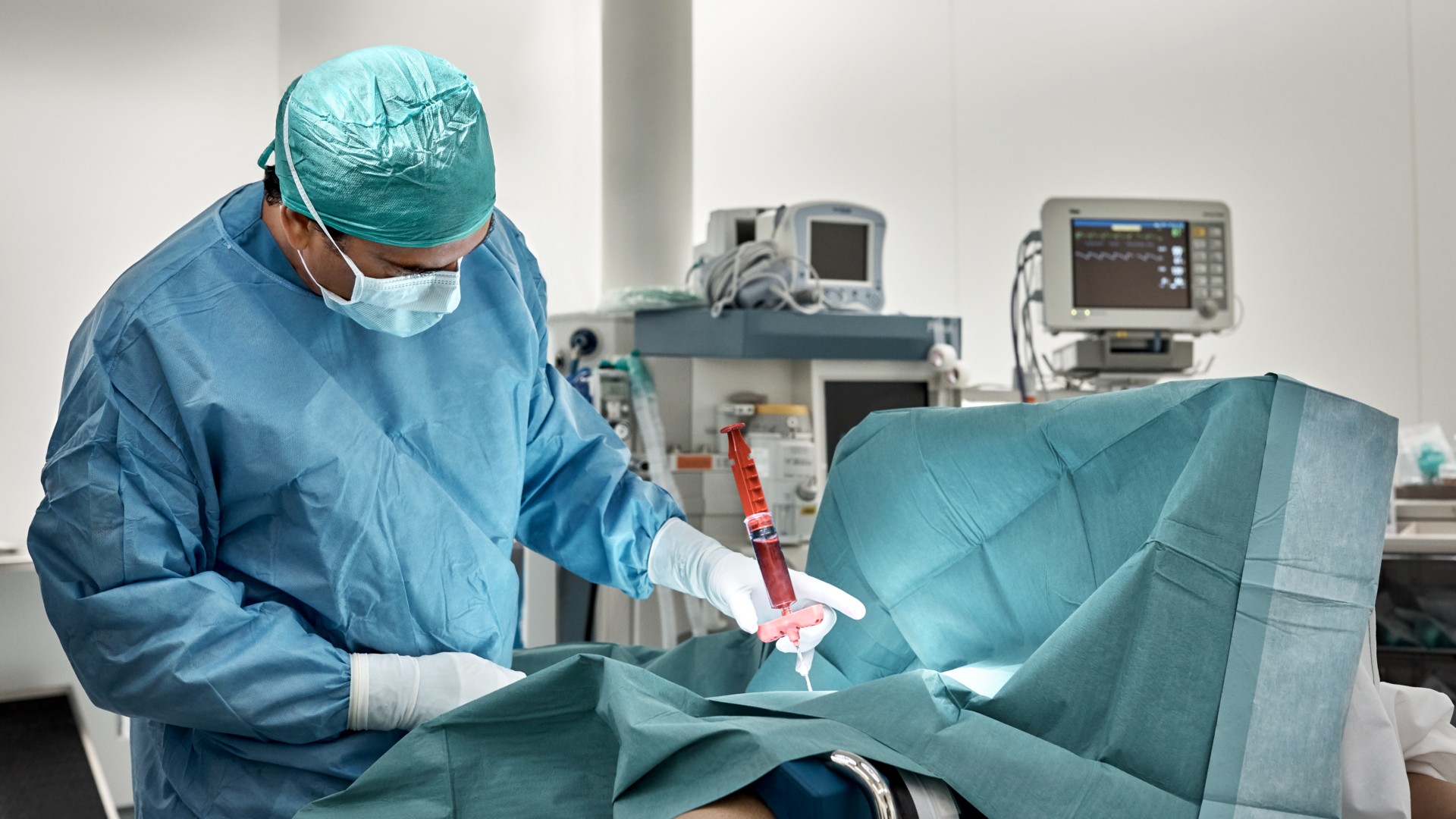1st-of-its-kind therapy blocks immune attack after stem-cell transplant
A midstage clinical trial suggests that a "first-of-its-kind" treatment could prevent serious immune attacks from bone-marrow transplants.

A new treatment may be able to prevent a common immune-related complication of lifesaving bone-marrow transplants, a midstage clinical trial shows.
In patients with blood cancer, high doses of chemotherapy or radiation therapy are used to kill the cancerous cells, but these treatments also damage the patients' healthy, blood-forming stem cells. To rectify this, doctors may perform a type of bone-marrow transplant known as an allogeneic hematopoietic stem cell transplant (HSCT), in which blood-forming stem cells from a healthy donor are transplanted into the cancer patient.
But there's a potential catch: Immune cells in the donor's tissue can sometimes attack the recipient's tissue, because the cells see it as foreign. A short-term form of this condition, called graft-versus-host disease (GVHD), affects around 40% of bone-marrow transplant patients, while different studies estimate that between 6% and 80% develop a chronic form of GVHD.
There are ways to reduce a patient's risk of this reaction, for example, by prescribing immune-suppressing drugs, but this reduces their ability to fight pathogens. There are also treatments that target a type of immune cell called T cells in the donor tissue. Although these therapies can be effective, they may come with an increased risk of cancer relapse or infection, the scientists behind the new trial wrote in a study published Jan. 4 in the journal Blood.
Related: Zika virus could potentially treat cancer, another early study hints
In contrast, the new treatment, called CD24Fc, derails the immune response at an earlier stage, by inhibiting the response of the cells responsible for activating T cells.
Specifically, the treatment prevents so-called antigen-presenting cells from activating donor T cells that would go on to attack the cancer patient's cells that have been damaged by radiation and chemotherapy before transplantation. These antigen-presenting cells can differentiate between the damaged host cells and pathogens, such as viruses, so CD24Fc only quietens the unwanted inflammation tied to GVHD and not other, helpful immune activity. As such, CD24Fc has also been trialed as a treatment for other conditions that are exacerbated by an off-the-rails immune response to tissue damage, such as severe COVID-19.
Get the world’s most fascinating discoveries delivered straight to your inbox.
"The molecular targets of the intervention are new and original," Dr. Ivan Maillard, a professor of medicine at the University of Pennsylvania who was not involved in the research, told Live Science in an email. CD24Fc kicks in right as the body senses the tissue damage associated with the transplant procedure, rather than later on, he said.
The new trial included 26 patients with blood cancer who received three doses of CD24Fc in the month before they underwent an allogeneic HSCT. They also received the standard, post-transplant immunosuppressive treatment. Of these patients, only one developed moderate-to-severe GVHD within six months of their surgery.
The researchers cross-referenced the trial participants' data to that of 92 patients who underwent the same procedure but without CD24Fc. These patients' results were pulled from a database, and 68 of the patients, or 74%, developed GVHD within six months.
Related: 'Bionic breast' could restore sensation for cancer survivors
The trial's results are "impressive," Dr. Javier Bolaños Meade, a professor of oncology at Johns Hopkins Medicine who was not involved in the research, told Live Science in an email. However, after a year, the researchers found no significant difference in overall survival rates, risk of chronic GVHD, or relapse rates between the two groups, which was "disappointing," he said.
CD24Fc caused minimal side effects in most patients, the authors wrote in the paper. However, two of the 26 patients developed a rare-but-serious skin disorder called Stevens-Johnson syndrome, which is normally caused by an adverse immune reaction to certain medications.
"Whether this rare complication was related to administration of CD24Fc cannot be excluded and will require careful monitoring and evaluation in future trials," Dr. Paul Martin, a professor emeritus of clinical research at the Fred Hutchinson Cancer Center in Seattle who was not involved in the research, wrote in a commentary accompanying the study.
The authors highlighted several limitations of the study, including that it was small and that the conclusions about CD24Fc's effectiveness stem from comparisons to historic data, rather than to a typical control group you'd expect in a gold-standard trial. This may have skewed the reliability of the findings for several reasons; for instance, the trial patients and historic patients may have differed from each other in key ways that weren't flagged or accounted for.
Nevertheless, Bolaños Meade and Maillard anticipate that there will be more studies testing this approach to GVHD prevention, which could provide more robust data about its effectiveness.
This article is for informational purposes only and is not meant to offer medical advice.
Ever wonder why some people build muscle more easily than others or why freckles come out in the sun? Send us your questions about how the human body works to community@livescience.com with the subject line "Health Desk Q," and you may see your question answered on the website!

Emily is a health news writer based in London, United Kingdom. She holds a bachelor's degree in biology from Durham University and a master's degree in clinical and therapeutic neuroscience from Oxford University. She has worked in science communication, medical writing and as a local news reporter while undertaking NCTJ journalism training with News Associates. In 2018, she was named one of MHP Communications' 30 journalists to watch under 30.



